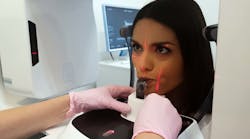As a dental hygienist I’m often asked by patients if they need the x-rays I’m recommending. There are so many opinions wrapped up around this essential diagnostic tool. And the truth is, you might not need them. But before you refuse them, here’s what you need to know.
Why does your dental office take x-rays?
Dental x-rays allow your provider to visualize areas we can’t see with our routine exam. Diseases of the mouth are often asymptomatic in their early stages. Catching something happening between your teeth or under the gums before you feel it matters in terms of extent of the treatment as well as your health, schedule, and wallet. Think of it like routine medical tests you might receive. A mammogram could detect cancer long before you feel the lump, or a cholesterol screening could alert you to make a lifestyle change or take some medicine years before you have a heart attack. Well, x-rays can help us detect something brewing long before you have a clue.
What can x-rays show?
Cavities
X-rays can help us find cavities in their very early stages. We can even see decay beginning and provide home care instructions to reverse that cavity before breaking out the drill. And if the cavity is large or underneath an existing restoration, we can provide you with a treatment plan so you know what to expect.
Infections
Early infections, or abscesses, often don’t cause discomfort. And for some reason, they can flare up at the worst possible times—like while you’re on vacation or when you have an important deadline. Having an x-ray of the roots of your teeth could give us the information we need to diagnose problems early and treat you on your schedule.
More Dear Patients:
How to know you can trust your dentist
How to choose a dentist (and how not to)
Gum disease
Early gum or periodontal disease is something we can diagnose with a visual exam. But having x-rays to show us the extent of the bone loss and the tartar that might be lurking underneath the gums helps us know how to treat you successfully.
Other issues
Tumors, cysts, and even clogged arteries have been found on x-rays and even saved lives. While not incredibly common, I’ve experienced this multiple times in my own operatory. Having the tools we need for early diagnosis leads to successful outcomes.
What are the types of x-rays?
While there are different types of x-rays you might encounter at the dentist for specific issues, there are some routine films that we might recommend.
Bitewings
These are sometimes called the “checkup x-ray.” They check in between your teeth for cavities, underneath existing restorations for recurrent decay, and to see radiographic bone loss. They are usually a series of two to seven x-rays, depending on the size and conditions in your mouth.
PA
A periapical x-ray (PA) is often of a single tooth from the chewing surface all the way to the tip of the root. These are useful to determine the cause of any discomfort, make sure a new filling or crown has smooth margins, or check on the nerve of the tooth.
Full mouth series
These x-rays combine both the bitewings and the PAs and it can feel like a million images, even though it’s usually about 18 to 20. These are a perfect baseline set of x-rays for your clinician. This way, if there’s ever an issue and we have to take a PA of a single tooth, we have something to compare it to. Have there been changes? Or has it always looked that way?
Panorex
A panorex is an extraoral (outside the mouth) x-ray. It provides us with a flat image of your teeth, jaw, and surrounding tissues all in one x-ray. These are extremely helpful in seeing emerging or impacted teeth and can help us diagnose tumors and joint issues.
CBCT
Cone Beam Computed Tomography is a relatively new technology that allows your provider to see a 3D image of your mouth. This x-ray is vital when performing root canals and placing implants. The CBCT scan allows your dentist to know how thick your bone is or see that nerve canal hiding in a traditional 2D x-ray.
How often should you get x-rays? Are they safe?
While there is a standard for the frequency of x-rays, your provider should consider your needs. We are all taught to expose x-rays under the ALARA principle: as low as reasonably achievable, meaning that while we recognize the benefit of x-rays, we strive to take as few as possible while not compromising your care.
If you are in your 30s and have never had a cavity, you likely don’t need those check-up x-rays yearly. But if you seem to have a cavity every time you come to the dentist, you might need them every six months to catch problems early. A general rule of thumb is bitewing x-rays yearly, a full mouth series every three to six years, and a panorex every three to six years. Having these films allows us to see in between your teeth, the roots of your teeth, and then surrounding structures in a reasonable interval to keep you from any surprises.







